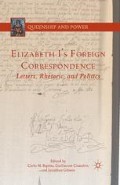Abstract
In his Opus de conscribendis epistolis, published in 1522, Erasmus of Rotterdam argues that a well-written letter should possess two features of crucial importance, namely flexibility and functionality In criticizing the overzealous rule-givers of his time for their slavish adherence to the Ciceronian model, he warns his contemporaries of the dangers of confining the structure and the language of a letter to suffocating prescriptions.1 He opts instead for a greater freedom in letter writing, remarking that an epistle, above all, needs to please the sender and the receiver, and must do justice to the subject-matter. Erasmus provides the practicing student with a large number of examples to follow, mostly derived from the Latin rhetorical tradition,2 nevertheless stating that the pupil should not be allowed to apply the rules mechanically, but should be encouraged, instead, to devise the best way to deal with the specific subject matter and recipient. This applies to a much greater extent to the mature and proficient letter writer, who should not be obsessed with a servile devotion to authoritative prescriptions, but should be free to develop a personal, distinctive voice.
Access this chapter
Tax calculation will be finalised at checkout
Purchases are for personal use only
Preview
Unable to display preview. Download preview PDF.
Notes
Erasmus’s later satirical dialogue Ciceronianus, published by Froben in 1528, directs a much more pointed critique at the imitators of Cicero. See Judith Rice Henderson’s discussion of Erasmus’s innovations in epistolography: “Erasmus on the Art of Letter Writing,” in James Jerome Murphy, ed., Renaissance Eloquence; Studies in the Theory and Practice of Renaissance Rhetoric (Berkeley and London: University of California Press, 1983), 331–55. Henderson contends that the De conscribendis can be considered a reaction both to the rigidity of the late tradition of the medieval ars dictaminis, and to the fashionable but blindly imitative adherence to Cicero’s style of a good number of the writer’s contemporaries.
Among the most influential Latin texts of classical rhetoric in the Renaissance are Rhetorica ad Herennium, Cicero’s De inventione and De oratore, and Quintilian’s Institutio oratoria. Peter Mack, A History of Renaissance Rhetoric, 1380–1620 (Oxford: Oxford University Press, 2011), remarks that De conscribendis epistolis was “a great and immediate success,” appearing in 74 editions from 1521 to 1559 (see 90). An educational perspective also informs one of the main sources of Erasmus’s rhetorical teaching, namely Quintilian’s Institutio oratoria.
Bajetta mentions Elizabeth’s suspicion, expressed during an audience of May 20, 1565, with Adam Zwetkovich, the emperor’s envoy, that the Archduke Charles had also proposed marriage to Mary Queen of Scots (“Three Holograph Italian Letters,” 125, note 13). Elizabeth and her Council, for their part, did not confine marriage negotiations to the Anglo-Austrian match, nor did they exclude in toto the possibility (advocated by Leicester and strongly opposed by Cecil) of a matrimonial alliance with Catholic France. See Wallace MacCaffrey, Elizabeth I (1993; London: Edward Arnold, 2004), 91.
“Nihil vel hodie vulgo tritius est quam haec Terentiana sententia: Quot homines, tot sententiae,” in Erasmo da Rotterdam: Adagia, no. 30, ed. Davide Canfora (Rome: Salerno Editrice, 2002), 188. Erasmus ascribes the saying to Terence in the first place, and then proceeds by listing a good number of slight variations deriving from authoritative Latin and Greek sources, such as Persius, Horatius, Euripides and lastly Homer. He also explores the possibility that Paul’s words in Romans, 14:5 allude to the same proverb: “One man esteemeth one day above another: another esteemeth every day alike. Let every man be fully persuaded in his own mind.” In his letter-writing manual De conscribendis epistolis, Erasmus comments upon the widespread habit of beginning a letter with the quotation of some “venerable ancient tag or memorable deed”—a practice, in his opinion, too fashionable among modern writers, which is not to be despised provided it be employed sparingly. See Collected Works of Erasmus, ed. J. K. Sowards (Toronto, Buffalo and London: University of Toronto Press, 1985), vol. 25, 78.
“If, therefore, you will weigh this matter with an even hand, it appears to me that such a concern has already been addressed.” The metaphor of weighing matters correctly (alternatively, with an even hand, in equal balance, or with the right/better scales) can also be found in a couple of French examples (a letter to Anjou, written in December 1579 or January 1580, and Letter 3, from late February 1580/1581, edited in Guillaume Coatalen’s and Jonathan Gibson’s essay in this volume), as well as in two holograph letters to James VI of Scotland (March 1586, and circa February 1, 1587). For a more detailed discussion of the “metaphor of the scales” see Giuliana Iannaccaro and Alessandra Petrina, “To and From the Queen: Modalities of Epistolography in the Correspondence of Elizabeth I,” Journal of Early Modern Studies 3 (2014): 69–89.
See Rayne Allinson, “‘These Latter Days of the World’: The Correspondence of Elizabeth I and James VI, 1590–1603,” Early Modern Literary Studies, Special Issue 16, 2 (October 2007): 1–27. http://purl.oclc.org/emls/si-16/allilatt.htm
For an examination of syllabi and textbooks to be found in the Elizabethan grammar schools and universities, see Peter Mack, Elizabethan Rhetoric: Theory and Practice (Cambridge: Cambridge University Press, 2002), in particular Chapters 1 and 2.
Editor information
Editors and Affiliations
Copyright information
© 2014 Carlo M. Bajetta, Guillaume Coatalen, and Jonathan Gibson
About this chapter
Cite this chapter
Iannaccaro, G. (2014). Elizabeth’s Italian Rhetoric: The “Maximilian Letters”. In: Bajetta, C.M., Coatalen, G., Gibson, J. (eds) Elizabeth I’s Foreign Correspondence. Queenship and Power. Palgrave Macmillan, New York. https://doi.org/10.1057/9781137448415_7
Download citation
DOI: https://doi.org/10.1057/9781137448415_7
Publisher Name: Palgrave Macmillan, New York
Print ISBN: 978-1-349-68630-8
Online ISBN: 978-1-137-44841-5
eBook Packages: Palgrave History CollectionHistory (R0)

